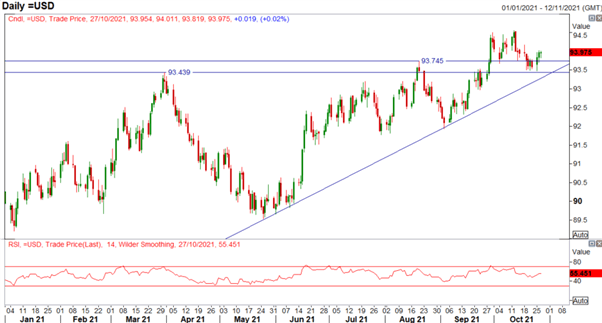US Dollar, AUD/USD Analysis and News
Today is value month end (T-2), which typically sees corporate USD demand and potentially explaining some of the upside we have seen in the greenback this morning. However, with US equities (S&P 500) up over 6% this month, there is a risk that USD slips during month end.
A brief explainer on month-end rebalancing….
London WMR Fix (1600 London Time): The WMR Fix is one of the most widely used benchmarks for FX trading, taking place every day within a 5-minute window around 1600 London time. The fix provides a standard set of currency benchmark rates so that equity and bond investors can compare portfolio valuations and performance with each other.
The WMR fix tends to coincide with a sharp rise in trading volume, prompting a sizeable increase in liquidity. Occasionally, this allows for large real money flows to take place without causing too many distortions. However, flows can also be dominant in one direction (strong buying or strong selling) leading to outsized moves in a very short period of time.
The largest bout of volatility stems from the month-end fix, taking place on the last business, where market extreme moves can often occur in the lead up during 15:00-16:00 London Time. These FX flows are derived from mostly equity rebalancing.
As such, if a UK portfolio manager holds US Dollar-denominated assets and seeks to hedge FX risk, then a monthly rise in the value of those assets will lead to more dollar hedging (selling the dollar). For example, if equities are FX hedged and US stocks (S&P 500) have risen on the month, while the FTSE 100 (UK stock market) has traded flat, then UK based investors would sell US Dollars against the Pound to add to their hedge, leading to an appreciation in GBP/USD.
The greater the outperformance of US equity market over the UK would be associated with greater selling of the USD against GBP, prompting GBP to rise even higher. Although, extreme moves can often partially revert in the day following the month-end fix. That said, the occurrence of such event in a market as liquid as FX, suggests that the London fix (month-end fix in particular) is important for FX traders to watch for.
Overall, G10 FX remains a choppy affair, the USD index is facing a test at the 94.00 handle, while further resistance resides at 94.15-20. On the downside, dip demand remains at 93.40-50. Elsewhere, the Australian Dollar continues to struggle maintaining a foothold above the 0.7500 handle, even after a firm inflation print overnight. As I said last week, 0.7515 and the 200DMA are areas to look for a pullback. What’s more, with copper prices extending its pullback this will likely keep the pressure on AUD upside.
US Dollar Chart: Daily Time Frame

Source: Refinitiv





